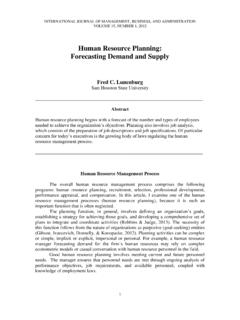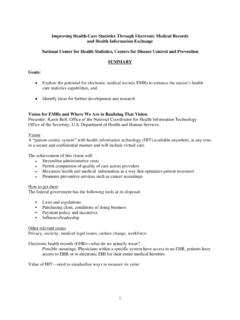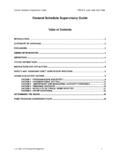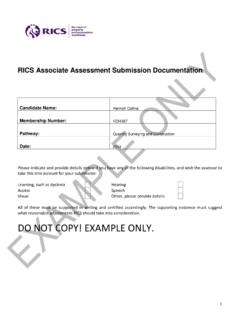Transcription of WHO | WHO 2019 - WHO | World Health Organization
1 -1- Rational use of personal protective equipment for coronavirus disease (COVID-19) and considerations during severe shortages Interim guidance 6 April 2020 Background This document summarizes WHO s recommendations for the rational use of personal protective equipment (PPE) in Health care and home care settings, as well as during the handling of cargo; it also assesses the current disruption of the global supply chain and considerations for decision making during severe shortages of PPE. This document does not include recommendations for members of the general community. See here: for more information about WHO advice of use of masks in the general community. In this context, PPE includes gloves, medical/surgical face masks - hereafter referred as medical masks , goggles, face shield, and gowns, as well as items for specific procedures-filtering facepiece respirators ( N95 or FFP2 or FFP3 standard or equivalent) - hereafter referred to as respirators" - and aprons.
2 This document is intended for those involved in distributing and managing PPE, as well as public Health authorities and individuals in Health care and home care settings involved in decisions about PPE use and prioritization; it provides information about when PPE use is most appropriate, including in the context of cargo handling. This document has been updated to address key considerations for decision making processes during severe shortages of PPE. Preventive measures for COVID-19 disease Based on current evidence, the COVID-19 virus is transmitted between people through close contact and droplets. Airborne transmission may occur during aerosol-generating procedures and support treatments ( tracheal intubation, non-invasive ventilation, tracheotomy, cardiopulmonary resuscitation, manual ventilation before intubation, bronchoscopy)1; thus, WHO recommends airborne precautions for these procedures.
3 For all, the most effective preventive measures include: maintaining physical distance (a minimum of 1 metre) from other individuals; performing hand hygiene frequently with an alcohol-based hand rub if available and if your hands are not visibly dirty or with soap and water if hands are dirty; avoiding touching your eyes, nose, and mouth; practicing respiratory hygiene by coughing or sneezing into a bent elbow or tissue and then immediately disposing of the tissue; wearing a medical mask if you have respiratory symptoms and performing hand hygiene after disposing of the mask; routine cleaning and disinfection of environmental and other frequently touched surfaces. In Health care settings, the main infection prevention and control (IPC) strategies to prevent or limit COVID-19 transmission include the following:2 1.
4 Ensuring triage, early recognition, and source control (isolating suspected and confirmed COVID-19 patients); 2. applying standard precautions3 for all patients and including diligent hand hygiene; 3. implementing empiric additional precautions (droplet and contact and, wherever applicable for aerosol-generating procedures and support treatments, airborne precautions) for suspected and confirmed cases of COVID-19; 4. implementing administrative controls; 5. using environmental and engineering Standard precautions are meant to reduce the risk of transmission of bloodborne and other pathogens from both recognized and unrecognized sources. They are the basic level of infection control precautions to be used, as a minimum, in the care of all patients. Additional transmission-based precautions are required by Health care workers to protect themselves and prevent transmission in the Health care setting.
5 Contact and droplets precautions should be implemented by Health workers caring for patients with COVID-19 at all times. Airborne precautions should be applied for aerosol-generating procedures and support treatments. Although use of PPE is the most visible control used to prevent the spread of infection, it is only one of the IPC measures and should not be relied on as a primary prevention strategy. In the absence of effective administrative and engineering controls, PPE has limited benefit, as described in WHO s Infection prevention and control of epidemic- and pandemic-prone acute respiratory infections in Health care. These controls are summarized here. Rational use of personal protective equipment for coronavirus disease (COVID-19) and considerations during severe shortages: interim guidance -2- Administrative controls include ensuring resources for infection prevention and control (IPC measures, such as appropriate infrastructure, the development of clear IPC policies, facilitated access to laboratory testing, appropriate triage and placement of patients, including separate waiting areas/rooms dedicated to patients with respiratory symptoms, and adequate staff-to-patient ratios, and training of staff.)
6 In the case of COVID-19, consideration should be given, wherever possible, to establish differentiated care pathways that minimize mixing of known or suspected COVID-19 patients with other patients ( through separate Health facilities, wards, waiting, and triage areas). Environmental and engineering controls aim at reducing the spread of pathogens and the contamination of surfaces and inanimate objects. They include providing adequate space to allow social distance of at least 1 m to be maintained between patients and Health care workers and ensuring the availability of well-ventilated isolation rooms for patients with suspected or confirmed COVID-19, as well as adequate environmental cleaning and Coveralls, double gloves, or head covers (hood) that cover the head and neck used in the context of filovirus disease outbreaks ( Ebola virus) are not required when managing COVID-19 patients.
7 Recommendations for optimizing the availability of PPE The protection of our frontline Health workers is paramount and PPE, including medical masks, respirators, gloves, gowns, and eye protection, must be prioritized for Health care workers and others caring for COVID-19 patients. In view of the global PPE shortage, strategies that can facilitate optimal PPE availability include minimizing the need for PPE in Health care settings, ensuring rational and appropriate use of PPE, and coordinating PPE supply chain management mechanisms (Figure 1). Figure 1. Strategies to optimize the availability of personal protective equipment (PPE) 1. Minimize the need for PPE in Health care settings The following interventions can minimize the use and need for PPE while ensuring that the protection Health care workers and others from exposure to the COVID-19 virus in Health care settings is not compromised.
8 Wherever feasible, use telemedicine and telephone hotlines to initially evaluate suspected cases of COVID-195, thus minimizing the need for these persons to go to Health care facilities for evaluation. Use physical barriers to reduce exposure to the COVID-19 virus, such as glass or plastic windows. This approach can be implemented in areas of the Health care setting where patients will first present, such as triage and screening areas, the registration desk at the emergency department, or at the pharmacy window where medication is collected. Postpone elective, non-urgent procedure, and hospitalizations, reduce frequency of visits for chronic patients, apply telemedicine and telephone solutions where possible so that Health care workers, wards, and PPE can be redistributed to services in which COVID-19 patients receive care.
9 Cohort confirmed COVID-19 patients without co-infection with other transmissible microorganisms in the same room in order to streamline the workflow and facilitate extended use of PPE (see below). Designate dedicated Health care workers/teams only for COVID-19 patient care so that they can use PPE for longer periods of time (extended use of PPE), if necessary (see considerations section below for details). Restrict the number of Health care workers from entering the rooms of COVID-19 patients if they are not involved in providing direct care. Streamline the workflow and reduce to a safe level care that requires face-to-face interaction between Health worker and patient. To do so, consider bundling activities to minimize the number of times a room is entered ( check vital signs during medication administration or have food delivered by Health care workers while they are performing other care) and plan which activities will be performed at the bedside.
10 Consider using specific PPE only if in direct close contact with the patient or when touching the environment ( wearing a medical mask and face shield, not using gloves or gown over the scrub suit, if entering the patient s room only to ask questions or make visual checks). Visitors should not be allowed to visit confirmed or probable COVID-19 patients, but if strictly necessary, restrict the number of visitors and the time allowed; provide clear instructions about what PPE is required to be used during the visit, about how to put on and remove PPE, and perform hand hygiene to ensure that visitors avoid exposure. 2. Ensure rational and appropriate use of PPE PPE should be used in combination with administrative and engineering controls. The indications for PPE should be Optimize PPE availability Minimize PPE needUse PPE appropriatelyCoordinate PPE supply chain Rational use of personal protective equipment for coronavirus disease (COVID-19) and considerations during severe shortages: interim guidance -3- based on the setting, target audience, risk of exposure ( type of activity) and the transmission dynamics of the pathogen ( contact, droplet, or aerosol).














